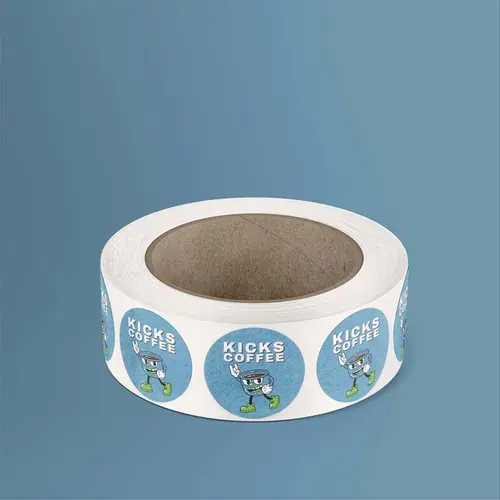Your Guide to Choosing the Right Material for Your Custom Labels
Not all labels are created equal, and the material you choose can make or break your product’s success. The wrong choice might leave you dealing with peeling corners, faded colours, or labels that simply don’t last as long as expected.
When exploring custom label printing options, the material selection process often feels overwhelming with so many choices available. Each material serves different purposes and environments, making the decision crucial for your product’s long-term performance and appeal.
Understanding Common Label Materials
Paper Labels for Indoor Applications: Paper remains the most economical choice for products stored indoors or in controlled environments. These materials work brilliantly for food packaging, retail items, and temporary applications where moisture exposure stays minimal. The natural texture provides excellent print quality and feels familiar to consumers.
Vinyl Materials for Durability: Vinyl labels excel in challenging conditions where paper would fail quickly. They resist moisture, chemicals, and temperature fluctuations whilst maintaining their appearance over extended periods. Many businesses choose vinyl for products that face harsh storage conditions or outdoor exposure.
Polyester Options for Premium Applications: Polyester delivers exceptional durability and maintains crisp graphics even under extreme conditions. This material choice appeals to brands seeking a premium feel and long-lasting performance. The slightly higher cost often pays dividends through reduced replacement needs and enhanced brand perception.
Durability Requirements for Different Applications
Water Resistance Considerations: Products destined for bathrooms, kitchens, or outdoor use need materials that handle moisture exposure gracefully. Standard paper labels curl and deteriorate when wet, creating an unprofessional appearance that damages brand credibility. Synthetic materials maintain their structural integrity even when submerged or exposed to humidity.
Temperature Tolerance Factors: Extreme temperatures test label materials in different ways, with heat causing adhesive failure and cold making materials brittle. Freezer products require specialised materials that remain flexible at low temperatures. Hot environments demand adhesives that won’t soften and cause label migration.
Chemical Resistance Properties: Products containing alcohol, oils, or cleaning agents need materials that won’t react with their contents. Some adhesives break down when exposed to certain chemicals, leading to label failure at critical moments. Understanding your product’s chemical environment prevents costly labelling disasters.
Adhesive Selection for Optimal Performance
Different adhesive types serve various purposes and removal requirements. Permanent adhesives create strong bonds that resist tampering and environmental challenges. Removable options allow clean removal without residue, perfect for reusable containers or temporary applications.
Permanent Adhesive Applications: Products requiring tamper evidence or long-term attachment benefit from permanent adhesive formulations. These create chemical bonds with surfaces that strengthen over time, making removal difficult without obvious damage. Security applications and warranty labels typically use permanent adhesives.
Removable Adhesive Benefits: Reusable packaging and promotional applications often require clean removal capabilities. Removable adhesives maintain their bond strength during use but release cleanly when needed. This flexibility proves valuable for seasonal promotions or multi-use containers.
Surface Material Compatibility
Surface preparation and material compatibility affect label performance significantly. Rough surfaces need stronger adhesives to fill microscopic gaps and create reliable bonds. Smooth surfaces allow standard adhesives to perform well but may require special formulations for challenging materials like silicone or Teflon.
Textured Surface Challenges: Rough or textured surfaces present unique bonding challenges that standard adhesives might not overcome effectively. These applications often require conformable materials that stretch and compress to follow surface contours. Understanding your container’s texture helps predict labelling success.
Low Energy Surface Solutions: Some plastic materials have low surface energy that prevents proper adhesive bonding. These surfaces require special adhesive formulations or surface treatments to achieve reliable attachment. Testing compatibility prevents field failures and customer complaints.
Aesthetic Finishes and Visual Impact
Label finish affects both appearance and functionality in ways that aren’t immediately obvious. Gloss finishes enhance colour vibrancy and create premium impressions but show fingerprints and scratches more readily. Matte finishes hide imperfections better and provide sophisticated appearances that many consumers prefer.
Gloss Finish Characteristics: High-gloss finishes make colours appear more vibrant and create eye-catching shelf presence. They’re particularly effective for products targeting younger demographics or impulse purchases. The reflective surface can create challenges in certain lighting conditions or when graphics include fine details.
Matte Finish Applications: Matte finishes convey sophistication and premium quality feelings that appeal to upmarket consumers. They resist fingerprints and provide excellent readability under various lighting conditions. Many craft and artisanal products benefit from matte finishes that complement their authentic positioning.
- Clear Labels: Create floating text effects that work brilliantly on transparent containers or products where the contents provide visual interest.
- Metallic Finishes: Add luxury appeal and shelf standout for premium products, particularly effective in cosmetics and spirits applications.
- Textured Materials: Provide tactile experiences that engage customers and reinforce quality perceptions through touch.
Cost Considerations and Value Analysis
Material Cost vs. Performance Trade-offs: Basic paper materials cost less initially but might require replacement sooner than synthetic alternatives. Premium materials command higher prices but often deliver better value through extended lifespan and enhanced brand perception. The total cost includes replacement labour and potential lost sales from poor presentation.
Volume Pricing Implications: Larger quantities typically reduce per-unit material costs, but inventory carrying costs increase with larger orders. Balancing order quantities against storage space and cash flow requirements helps optimise total labelling costs. Some materials have minimum order quantities that affect small-batch productions.
Long-term Value Assessment: Cheap materials that fail prematurely create hidden costs through replacement needs and damaged brand reputation. Premium materials that last the product’s entire lifecycle provide better value despite higher initial investment. Consider your product’s shelf life and storage conditions when evaluating material costs.
Quality Testing and Performance Validation
Testing label materials under actual use conditions prevents expensive mistakes and customer complaints. Accelerated aging tests help predict long-term performance without waiting months or years for real-world results. Many material suppliers provide testing protocols that simulate various environmental challenges.
Environmental Stress Testing: Temperature cycling, humidity exposure, and UV radiation tests reveal potential material weaknesses before full production. These tests help identify combinations that won’t perform adequately in target markets. Simple home testing can reveal obvious problems, but professional testing provides quantitative results.
Adhesion Performance Evaluation: Peel tests measure adhesive strength under controlled conditions and help predict field performance. Different test methods simulate various removal scenarios and help match adhesive strength to application requirements. Proper testing prevents both adhesive failure and removal difficulties.
Conclusion
Selecting appropriate materials for your labels determines whether they enhance or detract from your product’s success story. The right choice creates lasting impressions that build customer confidence and brand recognition over time. Poor material decisions often result in costly reprints, customer complaints, and damaged brand reputation that takes significant effort to rebuild. Take time to evaluate your specific requirements and test materials thoroughly before committing to large production runs.
Read more: Scaffolding Fall Injury? Why You Need a Specialized Accident Lawyer – SizeCrafter
Donating Your Body to Science After Death: A Complete Guide for Families – SizeCrafter
How Cooperative Procurement Transforms Purchasing Power for Schools and Universities – SizeCrafter

